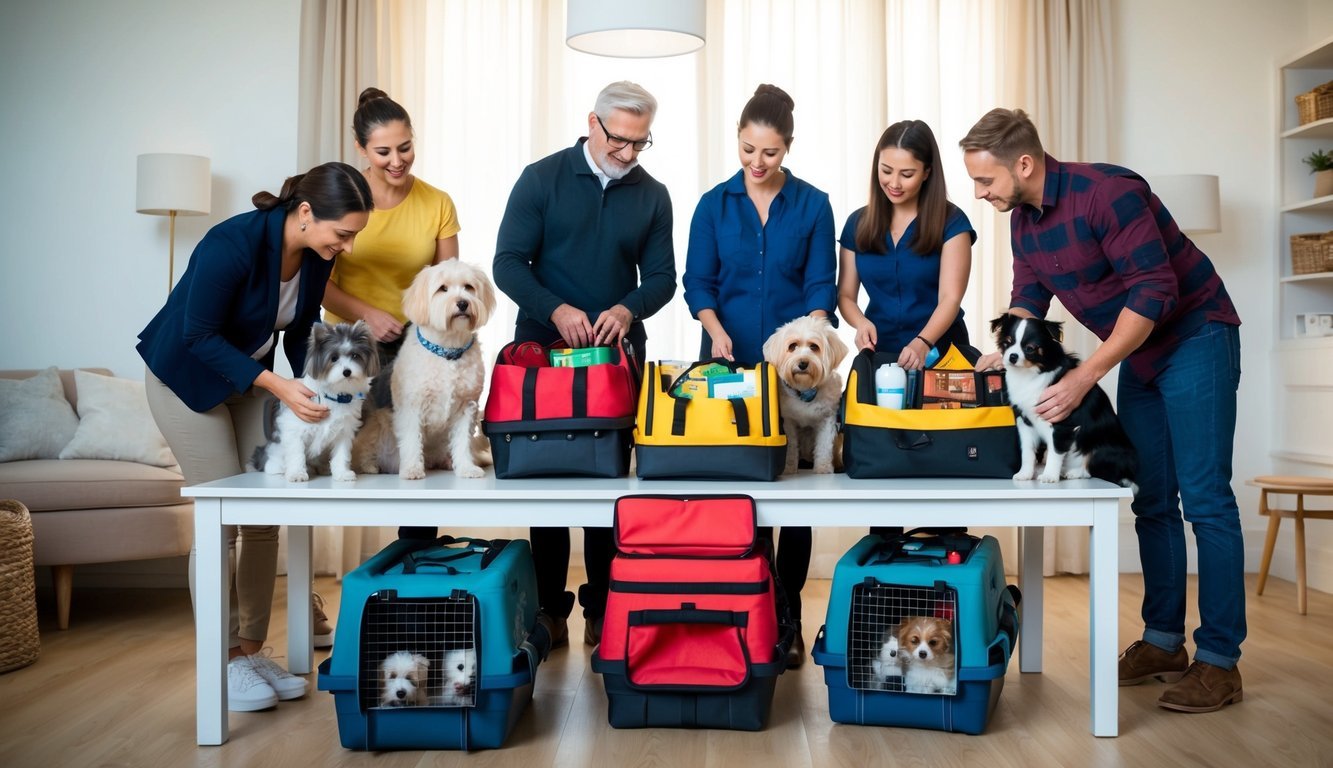September is National Disaster Preparedness Month, and as pet owners, we must remember to include our furry friends in our emergency plans. Our companion animals rely on us for their safety and well-being, especially during unexpected events.
Comprehensive Kit
Creating a comprehensive emergency kit for pets can mean the difference between life and death in a disaster situation. This kit should include essential items like food, water, and medications, as well as important documents and identification for your pet.
We often think of disasters as rare occurrences, but they can happen at any time. By taking proactive steps to prepare our pets for emergencies, we can ensure their safety and reduce stress for the whole family. Let’s explore some practical ways to keep our beloved animals safe when disaster strikes.
Understanding Disaster Preparedness for Pets

Pet owners need to be ready for unexpected emergencies. We’ll explore key aspects of keeping our furry friends safe when disaster strikes.
The Importance of a Plan
Creating an emergency plan for pets is crucial. We should identify pet-friendly evacuation routes and shelters in advance. It’s wise to prepare a pet emergency kit with essentials like food, water, medications, and first-aid supplies.
Including pets in disaster plans ensures their safety during crises. We must practice evacuation drills with our pets to familiarize them with the process.
Keeping digital copies of pet records and recent photos can be invaluable. We should also arrange a buddy system with neighbors or nearby family to check on our pets if we’re away during an emergency.
Types of Disasters and Their Impact on Pets
Different disasters pose unique challenges for pet safety. Hurricanes and floods may require evacuation, while earthquakes might trap pets indoors. Wildfires can spread rapidly, necessitating quick action.
During winter storms, we need to protect our pets from extreme cold. Tornadoes demand swift moves to secure shelter. Each disaster type requires specific preparations.
We should:
- Research common disasters in our area
- Tailor our pet emergency plans accordingly
- Prepare separate emergency kits for different scenarios
- Stay informed about local weather alerts and evacuation orders
Pet Identification and Microchipping
Proper identification is vital if we become separated from our pets during a disaster. We should ensure our pets wear collars with up-to-date ID tags at all times.
Microchipping provides an extra layer of protection. It’s a permanent form of identification that can’t be lost or removed. We must keep our contact information current in the microchip registry.
In addition to ID tags and microchips, we can:
- Use GPS trackers for added security
- Keep recent photos of our pets on hand
- Create “lost pet” flyers in advance
- Consider tattoos as a permanent ID option for some pets
Creating Your Pet’s Emergency Kit

Preparing an emergency kit for our pets is crucial for their safety and well-being during disasters. Let’s explore the essential items to include, ensuring our furry friends are ready for any situation.
Essential Emergency Supplies
We should start with the basics for our pet’s emergency kit. A sturdy, easy-to-carry container is ideal for storing supplies. Include copies of important documents like vaccination records and ownership papers in a waterproof bag.
Don’t forget a pet first aid kit with items such as gauze, bandages, and antiseptic wipes. A collar with ID tags and a leash are crucial for keeping our pets safe and identifiable.
It’s smart to pack a recent photo of our pet as touched upon earlier, in case we get separated. Add a list of emergency contacts, including our veterinarian’s information.
Food, Water, and Medicine
Nutrition and hydration are vital during emergencies. We need to pack enough food and water for at least two weeks for each pet. Don’t forget to include bowls and a manual can opener if needed.
For pets on medication, pack a two-week supply along with instructions. It’s wise to rotate these items regularly to ensure freshness.
Consider special dietary needs or preferences. If our pet eats wet food, pack extra in case refrigeration isn’t available.
Comfort Items and Sanitation
Our pets need comfort during stressful times. Pack familiar items like their favorite toy or blanket to help them feel secure.
For cats, include a small litter box, litter, and a scoop. Dogs will need waste bags for clean-up.
Consider including grooming supplies if we might be away from home for an extended period. A brush, pet wipes, and nail clippers can be helpful.
For smaller pets, don’t forget bedding material and any habitat accessories they might need.
Evacuation Strategies and Shelter Options
Being prepared for evacuations and knowing your shelter options are crucial for keeping pets safe during disasters. Let’s explore key strategies to ensure our furry friends are protected when we need to leave home quickly.
Preparing for an Evacuation
We need to have a solid plan in place for evacuating with our pets. It’s essential to keep pet carriers easily accessible and clearly labeled with our contact information. We should pack a go-bag for each pet containing food, water, medications, and comfort items.
Practice loading pets into carriers regularly to reduce stress during actual emergencies. As mentioned earlier, we can create a buddy system with neighbors to ensure someone can grab our pets if we’re not home during an evacuation order.
Keep our pets’ vaccinations up-to-date and have copies of medical records handy. It’s a good idea to microchip our pets and ensure the information is current.
Finding Pet-Friendly Shelters
Locating pet-friendly shelters in advance is crucial. We can contact our local emergency management office to get a list of shelters that accept pets. Many emergency shelters now accommodate pets, but it’s important to confirm their policies.
Some options to consider:
- Public shelters with pet facilities
- Animal shelters offering temporary housing
- Pet-friendly hotels or motels
- Friends or family members living outside the evacuation zone
We should keep a list of these options in our emergency kit, along with their contact information and any specific requirements they may have for pets.
Co-Sheltering with Your Pet During Disasters
Co-sheltering allows us to stay with our pets during a disaster, which can reduce stress for both pets and owners. Many emergency shelters now offer co-sheltering opportunities, recognizing the importance of keeping families together.
When co-sheltering, we need to:
- Bring our own pet supplies (food, water, bowls, litter, toys)
- Keep pets in carriers or on leashes at all times
- Be prepared to care for our pets ourselves
- Follow all shelter rules and guidelines
It’s important to remain calm and patient, as the shelter environment can be stressful for pets. We can create a small, familiar space for our pets using blankets or towels from home to help them feel more comfortable.
Staying Informed and Connected
Staying connected and informed is crucial for pet owners during disasters. We’ll explore how to leverage technology and tap into community resources to keep our furry friends safe.
Leveraging Technology and Apps
The FEMA app is a valuable tool for pet owners. It provides real-time alerts and safety tips tailored to various emergencies.
We can also sign up for wireless emergency alerts on our smartphones. These notifications keep us updated on local threats and evacuation orders.
NOAA Weather Radio is another excellent resource. It broadcasts continuous weather information, helping us stay ahead of approaching storms.
Many pet-specific apps are available too. They can store our pets’ medical records, identification details, and even help us locate pet-friendly shelters in emergencies.
Community and Professional Resources
Local animal shelters and veterinary clinics often offer disaster preparedness workshops. We should attend these to learn about pet emergency plans and build connections with other pet owners.
The ASPCA provides valuable online resources and disaster response services. They can guide us on creating pet “go bags” and offer support during emergencies.
We should familiarize ourselves with our community’s animal response capabilities. Many areas have dedicated teams trained to assist pets during disasters.
Joining local pet owner groups on social media can be helpful too. These networks often share timely information and support during crises.
Frequently Asked Questions
Preparing pets for disasters involves creating emergency kits, developing evacuation plans, and utilizing resources. We’ll address common questions to help ensure your furry friends stay safe when emergencies strike.
How can I create an emergency kit for my pet?
We recommend assembling a pet emergency kit with essential supplies. Include several days’ worth of food and water in airtight containers. Pack any medications your pet takes regularly. Add a first aid kit, collar, leash, and portable bowls.
Don’t forget comfort items like toys or blankets. Include copies of medical records and recent photos of your pet. A sturdy carrier or crate is crucial for safe transport during evacuations.
What are the essential steps to take for pet preparedness in case of a disaster?
Pet preparedness starts with identification. Ensure your pets wear collars with up-to-date contact information. Microchipping provides an extra layer of security if tags are lost.
Practice evacuation drills with your pets to familiarize them with the process. Identify pet-friendly shelters or hotels in advance. Keep vaccination records current, as many shelters require proof of immunization.
Why is it important to have a disaster plan for pets, and how do I make one?
A disaster plan for pets is crucial because animals are often overlooked in emergency situations. It ensures their safety and reduces stress for both pets and owners.
To make a plan, start by designating a caregiver who can take your pets if you’re unable to. Create a list of emergency contacts, including your veterinarian. Map out evacuation routes and identify pet-friendly accommodations along the way.
What should I include in my pet’s evacuation plan?
An effective pet evacuation plan includes multiple components. List several possible evacuation destinations, such as friends’ homes, pet-friendly hotels, or boarding facilities outside your area.
Prepare a go-bag with essentials that’s easily accessible. Practice loading pets into carriers quickly. Keep leashes and carriers near exits for rapid departure.
How can microchipping help during a disaster situation with pets?
Microchipping provides a permanent form of identification that can’t be lost or removed. If your pet gets separated during a disaster, shelters and veterinarians can scan the chip to access your contact information.
We recommend keeping your microchip registry information current. This increases the chances of reuniting with your pet if you become separated during an emergency.
What resources are available to help pets and their owners during emergencies?
Many organizations offer assistance during disasters. The ASPCA and other animal welfare groups often deploy rescue teams to affected areas.
Local emergency management offices can provide information on pet-friendly shelters. Some communities have volunteer groups that specifically assist with animal rescue and care during disasters.


